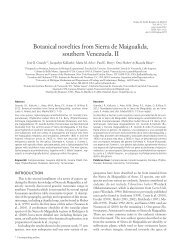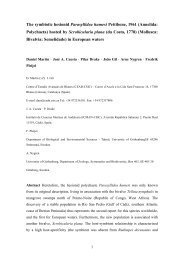PhD Thesis MJProl .pdf - digital-csic Digital CSIC - Consejo Superior ...
PhD Thesis MJProl .pdf - digital-csic Digital CSIC - Consejo Superior ...
PhD Thesis MJProl .pdf - digital-csic Digital CSIC - Consejo Superior ...
Create successful ePaper yourself
Turn your PDF publications into a flip-book with our unique Google optimized e-Paper software.
New strategies for the control of bacterial infections in marine fish larval rearing 9<br />
cultures (Salvesen et al., 2000). Microalgae are usually added together with their growth<br />
medium, so bacteria from microalgae cultures are added as well in the rearing tanks and<br />
may have an effect on the bacterial communities in the rearing tanks. Bacterial strains<br />
isolated from microalgae have shown in vitro antibacterial activity against fish<br />
pathogens (Makridis et al., 2006). The antibacterial effect of microalgae can be<br />
involved in a strategy to reduce the bacterial load in live feed organisms, when rotifers<br />
or Artemia are incubated in microalgae cultures (Makridis et al., 2006). It has been<br />
shown that an excessive bacterial content in live feed may overload the bacterial load in<br />
the rearing system and that larvae avoid live prey with high bacterial content (Pérez-<br />
Benavente and Gatesoupe, 1988).<br />
• Prebiotics<br />
Prebiotics are generally non-digestible diet compounds which cause a beneficial<br />
effect on the host by selecting growth or activating metabolism of one or a limited<br />
number of health-promoting bacteria (Gibson and Roberfroid, 1995). Research on<br />
application of prebiotics to aquaculture is still limited (Burr et al., 2005; Gatesoupe,<br />
2005; Gatlin et al., 2006). The capacity of non-digestible carbohydrates to support the<br />
growth of probiotic bacteria has been proved in vitro (Rurangwa et al., 2009) and in<br />
vivo trials have been conducted with dietary yeast culture or short chain fructooligosaccharides,<br />
which modified the intestinal microbial communities (Zhou et al.,<br />
2009).<br />
In fish larviculture, the prebiotics have a potential use in first feeding and during<br />
the weaning of larvae. Mahious et al. (2006), in assays with inulin and oligosaccharides<br />
in weaning of turbot (Psetta maxima) larvae, demonstrated a positive effect on growth<br />
and a predominance of Bacillus sp among bacterial isolates.<br />
1.2.1.2. Adding beneficial bacteria<br />
• Probiotics<br />
Probiotics, defined by FAO/WHO (2001) as “live microorganisms which, when<br />
administered in adequate amounts, confer a health benefit on the host”, constitute a<br />
potential tool in the reduction of mortalities in the rearing of aquatic organisms

















